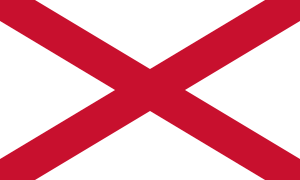Church of Ireland facts for kids
Quick facts for kids  Church of Ireland |
|
|---|---|
| Eaglais na hÉireann (Irish) Kirk o Airlann (Ulster Scots) |
|
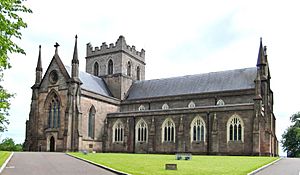
St Patrick's Cathedral, Armagh, seat of the Primate of All Ireland
|
|
| Classification | Protestant |
| Orientation | Anglican |
| Scripture | Protestant Bible |
| Theology | Anglican doctrine |
| Polity | Episcopal |
| Primate | John McDowell |
| Associations |
|
| Region | Ireland |
| Language | English, Irish |
| Headquarters | Church of Ireland House Church Avenue Rathmines Dublin D06 CF67 Ireland |
| Independence | 1871 (disestablishment) |
| Separated from | Roman Catholic Church in 1536 |
| Branched from | Theologically: Church of England |
| Congregations | 1100 places of worship 450 parishes |
| Members | 343,400 |
The Church of Ireland (Irish: Eaglais na hÉireann, Ulster-Scots: Kirk o Airlann) is a Christian church in Ireland. It is an independent part of the worldwide Anglican Communion. This church covers all of Ireland. It is the second-largest Christian church on the island, after the Roman Catholic Church. Like other Anglican churches, it keeps some older traditions. It also has bishops, but it does not follow the Pope's authority.
The Church of Ireland follows many ideas from the Reformation. This was a time of big changes in Christian churches. It sees itself as both "Reformed" and "Catholic." This means it believes it continues a long Christian tradition in Ireland. It also accepts changes from the Reformation. Different churches within the Church of Ireland have different styles of worship. Some are more formal, called "High Church." Others are simpler, called "Low Church."
The Church of Ireland runs many primary schools. In 2013, it had 174 primary schools. These schools had over 500 teachers and more than 13,500 students. There were also twenty high schools linked to the Church of Ireland.
Contents
What is the Church of Ireland?
The Church of Ireland believes it is part of the Irish Church that was changed by the Reformation. It traces its beginnings back to the early Celtic Church of St Patrick. This means it sees itself as both "catholic" (having a continuous tradition) and "protestant" (not following the Pope and accepting Reformation changes).
In the 12th century, the Irish Church changed its structure. It moved from being mainly run by monasteries to having dioceses and parishes. Many of today's church areas come from decisions made back then. This change was completed by the Synod of Kells in 1152.
Some experts believe early Irish Christianity was separate from Rome. But it shared many worship practices. This allowed both the Church of Ireland and the Catholic Church in Ireland to claim links to Saint Patrick.
In 1534, the English Parliament made Henry VIII the head of the Church of England. Two years later, the Irish Parliament did the same for the Irish church. Many bishops and clergy did not agree with this change. However, the Church of Ireland kept the church buildings and lands. Most Irish people stayed loyal to the Catholic Church. The Church of Ireland was the official state church of Ireland until 1871.
Today, the Church of Ireland is the second-largest religious group in the Republic of Ireland. It is the third-largest in Northern Ireland.
History of the Church
How the Church of Ireland Began
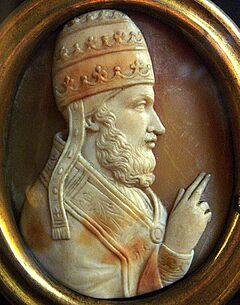
Christianity came to Ireland around the 5th century. Saint Patrick started his mission then. Before the 12th century, the Irish church was mostly independent of the Pope. It was run by powerful monasteries, not bishops.
In 1536, the Irish Parliament accepted Henry VIII of England as the head of the church. This was instead of the Pope. This event is seen as the start of the reformed Church of Ireland. It was confirmed when Henry became King of Ireland in 1541. The church grew under Edward VI. But Catholicism was brought back by his sister Mary I in 1553.

When Elizabeth I of England became queen in 1558, most Irish clergy were removed. This was because they did not accept her new religious rules. It was hard to find Irish-speaking ministers. So, a slower approach was used. People were allowed to use older worship practices. This was as long as they accepted the new church.
Translating the Bible into Irish was important. The New Testament was translated and printed in 1602. The Book of Common Prayer was also translated in 1606. An Irish version of the Old Testament came out in 1685.
The 17th Century Church

In the early 1600s, most native Irish people were Catholic. Protestant settlers in Ulster started their own Presbyterian church. A key leader for the Church of Ireland was James Ussher. He was Archbishop of Armagh from 1625 to 1656. In 1615, the Church of Ireland wrote its own beliefs. These were similar to the English church's beliefs.
Under King Charles I, the Church of Ireland said it was the original church. It argued that the Pope's power was a new idea. This idea was supported by Ussher. During the Irish Wars (1641–1653), much of Ireland was controlled by Catholics. The Church of Ireland was re-established after 1660. Meetings by other Protestant groups and Catholics were made illegal. But these laws were not always strictly followed.
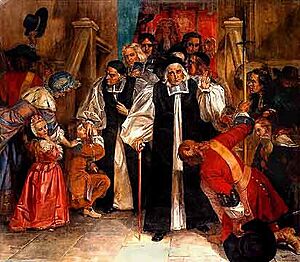
In 1685, the Catholic James II became king. Many people supported him at first. But his actions seemed to attack the official church. This changed public support. Ministers of the national churches had to promise loyalty to the king. When James was replaced by Mary II and William III, some ministers refused to make a new promise. This caused a split.
The Church of Ireland was less affected by this. The "Protestant Ascendancy" in Ireland began around 1691. This was when the Treaty of Limerick ended a war. The Church regained control. In 1697, a law expelled Catholic bishops and some clergy from Ireland.
The 18th Century Church

In 1704, a law called the Test Act was extended to Ireland. This law meant that only members of the Church of Ireland could hold public office. This law stayed until 1829. However, some Catholics found ways around these rules. For example, some Catholic families raised their sons as Protestants.
Fewer than 15-20% of Irish people were members of the Church of Ireland. It was a minority church. It faced challenges from both Catholics and other Protestants. A law in 1719 allowed other Protestants to worship freely.
In the 17th century, religious and political beliefs were often seen as the same. Catholics were sometimes seen as a threat just because of their religion. In the 18th century, people started to feel more Irish. In 1749, Bishop Berkeley asked Catholic clergy to work with the church for Ireland's good. After 1750, the government started to allow more rights for Catholics. This was to reduce the power of Protestant groups who wanted Ireland to be independent. This movement ended after the 1798 Rebellion. Ireland then joined with Britain.
The 19th and 20th Centuries
After Ireland joined with Great Britain in 1800, the Church of Ireland also joined the Church of England. They formed the "United Church of England and Ireland." Some Irish bishops were given seats in the British Parliament.
The Irish Church had many bishops for its size. In 1833, a law reduced the number of bishops from 22 to 12. This law also made financial changes. It was part of bigger reforms and caused political disagreements.
Another problem was how the church was funded. Everyone in Ireland had to pay "tithes" to the church. This was true even if they were not members. This caused anger. For example, one church leader received a lot of money each year. But his parish had no Protestants or even a church. The "Tithe War" (1831–36) changed this system. But tithes did not fully disappear until 1869.
The 1869 law ended the Church of Ireland's status as a state organization. Its bishops were removed from Parliament. Its property was given to the government. The church received some money in return. But parishes found it hard to get money locally after losing their lands.
The Church of Ireland saw a big drop in members during the 20th century. This happened in both Northern Ireland and the Republic of Ireland. Today, it is still the second-largest church in the Republic of Ireland. It is the third-largest in Northern Ireland.
How the Church is Run
The main leader of the Church of Ireland is the Archbishop of Armagh. In 1870, the church set up its own government. This was led by a General Synod. It also had a Representative Church Body for money and administration. The Church of Ireland did not split when Ireland was divided in the 1920s. It still runs across all of Ireland.
Church Structure
The Church of Ireland has a system of bishops, like other Anglican churches. It keeps the old structure from before the Reformation. This means it has local parishes grouped into dioceses. Historically, there were over 30 dioceses. Today, there are eleven dioceses. Each is led by a bishop. They belong to one of two main areas, called provinces.
The leader of the southern province is the Archbishop of Dublin. Currently, this is Michael Jackson. The leader of the northern province is the Archbishop of Armagh. Currently, this is Francis John McDowell. The Archbishop of Armagh is seen as the overall leader and spokesperson for the church.
General Synod and Decisions
Important decisions about beliefs, church laws, and how the church is run are made by the general synod. The general synod has two parts: the House of Bishops and the House of Representatives. The House of Bishops includes the 10 bishops and two archbishops. The House of Representatives has clergy (church leaders) and lay members (regular church members). The clergy have one-third of the seats. Lay members have two-thirds. In 2017, there were 216 clergy and 432 lay members. These members are chosen every three years. The general synod meets once a year.
To change church policy, a simple majority vote is needed from both Houses. To change church beliefs, like allowing women to be priests, a two-thirds vote is needed from both Houses. The two Houses usually meet together. But they vote separately on some issues.
Representative Church Body
The "Representative Church Body" (RCB) manages the church's money and property. It is the official trustee of the church. Most of the church's property is held by the RCB. The RCB members include bishops and other church representatives. They meet at least four times a year. The RCB staff manage property, investments, salaries, and pensions. They also run the church library.
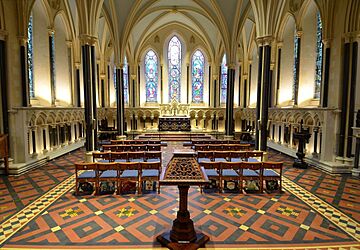
Church Leaders and Roles
The Church of Ireland has three main types of ministers: deacons, priests, and bishops. These are different from specific jobs like rector or canon.
How Dioceses are Run
Each diocese is led by its bishop or archbishop. They may have other leaders, like Archdeacons, to help them. Each diocese also has a diocesan synod. This synod includes the bishop, clergy, and lay members from the parishes. They oversee how the diocese works.
How Parishes are Run
Each parish has a main church leader. They are helped by two churchwardens. One warden is chosen by the church leader. The other is chosen by a vote of the church members. All adult members of the parish meet once a year. This meeting is called the Easter Vestry. There is also a smaller group called the select vestry. This group helps manage the parish and its church buildings.
Cathedral Management
There are special rules for managing five main cathedrals. These are in Dublin (which has two), Armagh, Down, and Belfast.
The Church Today
Membership Numbers
The Church of Ireland's membership decreased a lot in the 20th century. In 2016, it had 126,414 members in the Republic of Ireland. This was a small drop from 2011. In Northern Ireland, it has about 260,000 members. It is the third-largest church there. In 2013, the church reported that about 58,257 people attended church on an average Sunday. Most of these attendees were in the northern part of Ireland.
Cathedrals
The Church of Ireland has two cathedrals in Dublin. Christ Church Cathedral is the main church for the Archbishop of Dublin. St Patrick's Cathedral is the National Cathedral for Ireland. Other dioceses also have their own cathedrals.
The main cathedral for all of Ireland is St Patrick's Cathedral in Armagh. This is the church of the Archbishop of Armagh, John McDowell.
Training for Church Leaders and Teachers
The church's main offices are in Rathmines, Dublin. The church library is in Churchtown. Teachers for Church of Ireland schools are now trained at Dublin City University. The church also has a seminary, the Church of Ireland Theological Institute, in Rathgar, Dublin. This is where priests are trained.
Education for Young People
The Church of Ireland is involved in education for young people.
Connection to the Anglican Communion
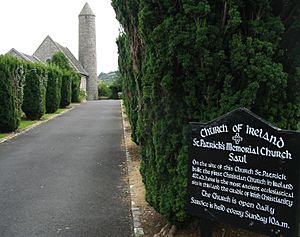
The churches of the Anglican Communion are connected by shared beliefs and loyalty. They are all in full communion with the Archbishop of Canterbury. He is a key leader for Anglican unity. He calls the Lambeth Conference, which happens every ten years. He also leads meetings of church leaders.
The Church of Ireland is generally on the "Low Church" side of Anglicanism. This means its worship is often simpler. It was one of the first Anglican churches to be governed by a synod (a church council) after it stopped being a state church in 1871. It was also one of the first to start allowing women to become priests in 1991.
Working with Other Churches
The Church of Ireland works with many other Christian groups. It is a member of the World Council of Churches, the Conference of European Churches, Churches Together in Britain and Ireland, and the Irish Council of Churches. It is also part of the Porvoo Communion.
Flags in the Church
In 1999, the church voted to only allow the St Patrick's flag and the Flag of the Anglican Communion to be flown on church property. However, the Union Flag is still flown on many churches in Northern Ireland.
Church Publications
The Church of Ireland has an official website. Its newspaper is The Church of Ireland Gazette. This newspaper is independent, but its governing body is chosen by the church. Many local churches also create their own newsletters and websites.
Beliefs and Practices
The main teaching of the Church of Ireland is about the life, death, and resurrection of Jesus Christ. Here are some basic beliefs:
- They believe Jesus Christ is both fully human and fully God. He died and came back to life.
- Jesus offers a way to eternal life for those who believe.
- The Old and New Testaments of the Bible are seen as "God's Word written." They were written by people inspired by the Holy Spirit. The Apocrypha are extra books that can be read, but not used to decide church beliefs.
- The two most important sacraments are Baptism and the Eucharist (also called Holy Communion).
- Other important practices, sometimes called sacraments, include confirmation, ordination (making someone a priest), marriage, and anointing the sick.
- They believe in heaven, hell, and Jesus's return.
A 16th-century thinker named Richard Hooker suggested that Anglicans use three sources for their beliefs: the Bible, tradition, and reason. The Bible is the main source for beliefs. If something is not clear in the Bible, tradition helps decide. Reason then checks both.
Modern Discussions
Women in Ministry
In recent years, the church has allowed women to serve in all church roles. In 1984, the church allowed women to become deacons. In 1987, the first woman, Katherine Poulton, became a deacon. In 1990, the church started allowing women to become priests. The first two women priests were Kathleen Margaret Brown and Irene Templeton. In 2013, the church appointed its first female bishop, Pat Storey.
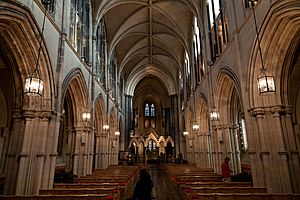
Worship Practices
Irish Language
The first translation of the Book of Common Prayer into Irish was published in 1606. A later Irish translation came out in 1712.
The Church of Ireland has a group called Cumann Gaelach na hEaglaise. This group was started in 1914. It brings together Church of Ireland members who are interested in the Irish language and Irish culture. It aims to promote the Irish language within the church. This group holds services in Irish twice a month.
From 1926 to 1995, the church had its own college for training Irish-language teachers. Today, there are schools where teaching is done through the Irish language. These schools are open to students from different churches.
More to Explore
- Anglo-Irish
- Church of England
- Scottish Episcopal Church
- Episcopal Church (United States)
- Church in Wales
- Protestantism in Ireland
- Religion in Northern Ireland
- Religion in the Republic of Ireland
See also
 In Spanish: Iglesia de Irlanda para niños
In Spanish: Iglesia de Irlanda para niños



